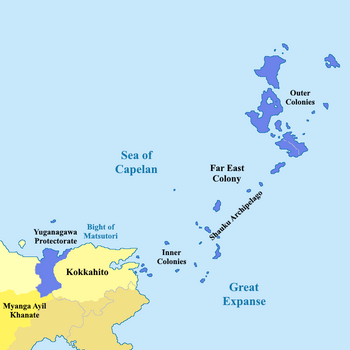Yuganagawa Protectorate: Difference between revisions
Tags: Mobile edit Mobile web edit Advanced mobile edit |
Tags: Mobile edit Mobile web edit Advanced mobile edit |
||
| Line 79: | Line 79: | ||
Yuganagawa was treated by the [[Oyashima#Early_modern_era|Ai dynasties]] as a {{wp|Prefectures_of_Japan#Ken|Ken Prefecture}} ruled over by a {{wp|Hatamoto}}-{{wp|Epistates}} appointed by the Duke of Marialanus and ordained by the Emperor. | Yuganagawa was treated by the [[Oyashima#Early_modern_era|Ai dynasties]] as a {{wp|Prefectures_of_Japan#Ken|Ken Prefecture}} ruled over by a {{wp|Hatamoto}}-{{wp|Epistates}} appointed by the Duke of Marialanus and ordained by the Emperor. | ||
Beneath the {{wp|Hatamoto}}-{{wp|Epistates}} existed a complex bureaucratic structure. The UTC, known for its efficiency, implemented a tiered system. Upper echelons were staffed primarily by [[Dericania]]n officials, responsible for trade, taxation, and military matters. Lower administrative positions were gradually filled by {{wp|Japanese|Mutsotori}} people who demonstrated competence and loyalty. This localization helped bridge the cultural gap and eased tensions between the rulers and the ruled. As the territory expanded beyond the the initial realm of the Kokko new fiefs were assigned to [[Patroon]]s. | Beneath the {{wp|Hatamoto}}-{{wp|Epistates}} existed a complex bureaucratic structure. The UTC, known for its efficiency, implemented a tiered system. Upper echelons were staffed primarily by [[Dericania]]n officials, responsible for trade, taxation, and military matters. Lower administrative positions were gradually filled by {{wp|Japanese|Mutsotori}} people who demonstrated competence and loyalty. This localization helped bridge the cultural gap and eased tensions between the rulers and the ruled. As the territory expanded beyond the the initial realm of the Kokko new fiefs were assigned to [[Patroon]]s both of {{wp|Japanese|Mutsotori}} and [[Dericania]]n descent. | ||
==See also== | ==See also== | ||
Revision as of 18:57, 2 April 2024
| This article is a stub. You can help IxWiki by expanding it. |
Yuganagawa Protectorate Protectorat Marialanii de Yuganagawa | |
|---|---|
| 1635-1747 | |
|
Flag | |
 Yuganagawa Protectorate in the 1720s | |
| Status | Marialanii Protectorate province of Kokkahito |
| Official language | Burgoignesc |
Common languages | Mutsutori |
| Religion | Shinto |
| Government | Constitutional monarchy |
| Hatamoto-Epistates | |
| Historical era | Age of Discovery, Age of Sail |
• Established | 1635 |
• Disestablished | 1747 |
| Today part of | |
The Yuganagawa Protectorate was formed as the Ai Dynasty recognized the growing threat of the Myanga Ayil Khanate from the west. Impressed by the martial prowess of the Ularien Trading Company (UTC) during the Sea Lords-Daimyo Wars, the Empress made a bold proposal. She offered the Company the opportunity to establish a marcher territory in the western portion of Kokkahito. This territory, named Yuganagawa, would serve as a crucial defense against Myanga Ayil Khanate incursions and protect the Ai's vital trade routes. The UTC readily accepted this proposition. Establishing Yuganagawa provided strategic benefits for both entities. The Ai gained a bulwark against the Khanate, while the UTC secured a entrepot from which to expand their influence further east. Additionally, Yuganagawa offered an opportunity for economic development, with the potential to exploit natural resources for the benefit of the Company.
The establishment of Yuganagawa marked a shift in focus for the UTC. For the next decade, the Company's energies shifted towards expanding the territory southward. This strategy aimed to put pressure on the northern flank of the Myanga Ayil Khanate and relieve pressure on the Duchy of Marialanus' Cote d'Or colony in modern day Kandara.
Governance and administration
Yuganagawa was treated by the Ai dynasties as a Ken Prefecture ruled over by a Hatamoto-Epistates appointed by the Duke of Marialanus and ordained by the Emperor.
Beneath the Hatamoto-Epistates existed a complex bureaucratic structure. The UTC, known for its efficiency, implemented a tiered system. Upper echelons were staffed primarily by Dericanian officials, responsible for trade, taxation, and military matters. Lower administrative positions were gradually filled by Mutsotori people who demonstrated competence and loyalty. This localization helped bridge the cultural gap and eased tensions between the rulers and the ruled. As the territory expanded beyond the the initial realm of the Kokko new fiefs were assigned to Patroons both of Mutsotori and Dericanian descent.
